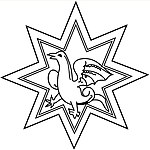Helen of Sweden (13th century)
| Swedish Royalty |
| House of Sverker |
|---|
 |
| Sverker I |
|
| Charles VII |
|
| Boleslaw, Kol |
| Sverker II |
|
| John I |
Helen of Sweden (c. 1190 – 1247,[
Biography
Helen was born in
Helen Sverkersdotter, the only daughter of the deposed king, was educated at Vreta Abbey at the time of her father's death. Around 1210, Helen was one of the victims of the Vreta abductions.
Sune Folkesson was from one of the two dynasties that had been rivals for the Swedish throne since 1130, while Helen was from the other, the
In 1216, Helen's brother became King John I of Sweden. When he died childless in 1222, Helen and her daughters became heirs of the Sverker dynasty. In 1243, her daughter, Catherine Sunesdotter (c. 1215 – 1252), was married to King Eric XI, thus finally uniting the two Swedish dynasties.
Around 1244,
References
- ^ "Helena". Svenskt biografiskt lexikon. Retrieved April 1, 2020.
- ^ "Sune Folkesson". Svenskt biografiskt lexikon. Retrieved April 1, 2020.
- ^ "Svantepolk Knutsson". Svenskt biografiskt lexikon. Retrieved April 1, 2020.
Other sources
- Lars O. Lagerqvist (1982). "Sverige och dess regenter under 1.000 år",("Sweden and its regents under a 1000 years") (in Swedish). Albert Bonniers Förlag AB. ISBN 91-0-075007-7.
- Borænius, Magnus i Klostret i Vreta i Östergötland 1724 & 2003 s. 31
Related reading
- Lars O. Lagerqvist (1982) Sverige och dess regenter under 1.000 år (Stockholm: Bonniers Förlag AB) ISBN 91-0-075007-7
